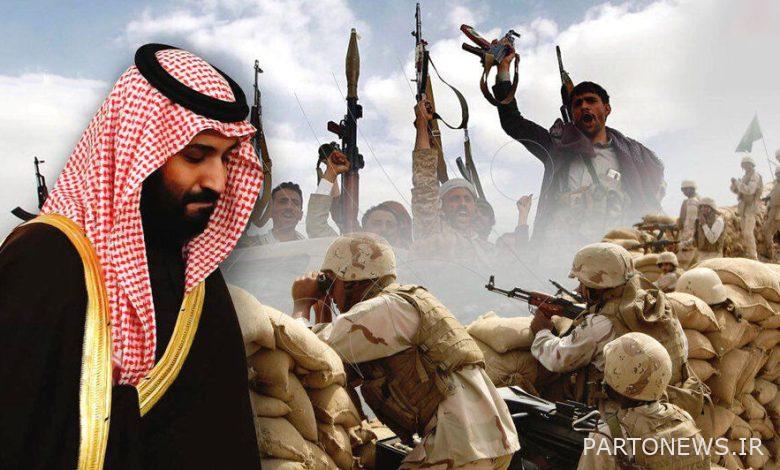Examining the cost of Saudi policies in the region and Yemen

Another goal of Muhammad bin Salman since the beginning of the Yemeni war was to gain hegemony from Saudi Arabia (the dominant power) among the Arab countries, but this goal was not only not achieved, but Saudi Arabia is now recognized as the failure of the fruitless war in Yemen. Saudi
It is a long way.
If we take a look at bin Salman’s six-year record since he first became the Minister of Defense and then the Crown Prince of Saudi Arabia, we will see that he has gone bankrupt due to miscalculations.
It can be said that Bin Salman’s action in increasing the extraction and uncontrolled export of oil after the invasion of Yemen, which began on April 26, 2015, has been the strangest policy of the Saudis in recent years; Decisions that cause huge damage alongside the Corona epidemic
The global economy has entered the Saudi economy in particular.
The International Monetary Fund (IMF) has said in a report on the financial situation of Saudi Arabia that it owed $ 233 billion (873 billion Saudi riyals) from its financial reserves during the reign of the current King of Saudi Arabia Salman bin Abdulaziz (since 2015) and his son Mohammed bin Salman.
It is clear what he has lost, or in other words, he has invaded Yemen. However, this figure is estimated by Yemeni informed sources to be more than $ 300 billion in the more than six-year war in Yemen.
David Hurst, a British journalist and Middle East expert, wrote in an article on Saudi Arabia’s economic developments and its challenges in the face of falling oil prices that the Saudi regime has raised $ 233 billion since Salman bin Abdulaziz took office in 2015. From
Has lost its financial reserves.
The International Monetary Fund (IMF) has also stated in its report that since 2015, the death of former King Abdullah bin Abdulaziz, although Saudi Arabia’s financial reserves are very high, astronomical sums of nearly one trillion Saudi riyals have been spent on it.
According to these reports, the financial reserves of the Saudis at the Central Bank of Saudi Arabia in December 2014 were 2,746 billion rials ($ 732 billion), but this figure gradually went down during the reign of King Salman, so that in December 2019 To one thousand and 873 billion rials
($ 499 billion) and this trend means that the Saudi treasury has lost 233 billion dollars during this period and 46 billion and 600 million dollars have been melted from the treasury every year.
According to the report, the Saudis never specified what the property was spent on and what it was spent on, but analysts believe that this large sum was the cost of the Saudi war in Yemen. The amount is equal to the budget of the 18-year administration of some Arab countries
Like Jordan and Tunisia.
The report states that this amount is related to before the fall in oil prices, which began in March (early March 1998). The money disappeared from the Saudi treasury while oil prices were still high at the time. Oil prices from the first week of the month
March 2009 began to decline and fell in mid-April (mid-April 99). Also, the Saudis’ large incomes from Hajj and Umrah have been stopped due to the outbreak of the Corona virus, and not a single traveler has entered Saudi Arabia since the outbreak of the virus.
In recent years, Saudi Arabia has been fully obeying US orders and implementing Washington’s regional policies in the region. Intensification
Has been.
Bin Salman’s inauguration in Saudi Arabia coincided with the inauguration of Donald Trump in the United States, two events that not only caused countless losses to his own country, but also caused a great deal of damage to all countries in the world.
The latest case is the drop in oil prices in recent years.
According to published reports, Saudi Arabia has spent about $ 200 billion in recent years to destabilize Syria, Iraq and other countries in the region by equipping and arming terrorist groups.
Add to that the fact that the Saudi regime has spent nearly $ 500 billion of its oil revenues on extremist militarization in the region.
If we take a brief look at Saudi Arabia’s revenues over the past 10 years and look at the loans that Saudi Arabia has taken from foreign banks in recent years, we can see that Al-Saud, especially the Crown Prince, is not in charge.
In 2009 and 2010, the price of oil was over one hundred dollars per barrel, and at the same time, Saudi Arabia exported about six million barrels of oil, meaning that Saudi Arabia earned more than six hundred million dollars a day from oil exports, which is 225 per year.
It was $ 1 billion, and Saudi Arabia’s two-year oil revenue was $ 450 billion.
This trend of Saudi oil exports (six million barrels per day) continued until April 2009, with the difference that oil prices reached about $ 60 per barrel, ie Saudi Arabia’s revenues were approximately $ 135 billion in one year and in eight years (since 1390 to 1398)
It also amounted to about one trillion and 80 billion dollars, from which, of course, the cost of extraction and transportation must be deducted.
Saudi Arabia, as the largest oil exporter in the world, also increased its production level from 9 million and 800 thousand barrels to 12 million and 300 thousand barrels per day from April 2009, of which about 9 million barrels at a price of about 50 to 60 Has issued dollars.
Saudi Arabia, in what many called a “conspiracy”, increased its oil production and exports by one million barrels a day on March 13, 2017, due to tensions between Moscow and Riyadh, and in order to hit Iran’s economy. To more than 13 million barrels in
It was a purely suicidal act due to the coronavirus epidemic and the severe economic recession in the world and the closure of factories and industries, because with this action of the Saudis, the world oil price suddenly fell and some markets the price was zero dollars. Per barrel
They experimented and the American markets even announced that they would pay $ 37 per barrel, which means that in the American markets, oil fell to minus $ 37.
The situation in Saudi Arabia these days is very different from the past; In previous years, Saudi Arabia used to give low-interest or free loans to other countries due to large oil revenues, and it was the scene of the wars in Syria, Iraq, Libya and Yemen, but now the conditions for the Saudis
It has taken a different turn, and the pity of oil dollars has led the Saudis to borrow from world banks.
After Salman bin Abdulaziz became king in Saudi Arabia (January 2015) and his son Mohammed became defense minister in the same year (Mohammed bin Salman also became the crown prince of Saudi Arabia in 2017), the Saudis adopted adventurous and aggressive policies, especially military strikes. to the
Yemen and its continued involvement in proxy wars in Syria, Iraq, and Libya have spent large sums of money on weapons, accelerated by the inauguration of President Donald Trump, who visited Riyadh on May 20. 2017, large purchase contracts
$ 460 billion worth of military weapons were concluded between the United States and Saudi Arabia.
The available information and news show that in recent years, most of Saudi Arabia’s large oil revenues have been spent only on wars in which the most casualties and financial losses have been inflicted on Muslims in Syria, Iraq, Libya and Yemen.
Another of Bin Salman’s projects, which is estimated to cost $ 500 billion and has been implemented since June 2009, is the Neom project, a project that even Saudi allies have expressed disappointment with its success. So much so that the Wall Street Journal
“Although Saudi Crown Prince Mohammed bin Salman intends to make the Neom project as realistic as science fiction, the facts do not allow him to realize this dream,” the Journal wrote in a report.
In his dream, Bin Salman wants to attract the biggest brains and the best talents in the world by building this city-country and pay them the highest salaries in the world.
Another huge damage that bin Salman’s policies and plans have done to the region since taking office in Saudi Arabia is the damage that affects both Yemen and Saudi Arabia; Damages inflicted on Yemen due to the six-and-a-half-year aggression of the Arab coalition with
American aid is enormous, estimated at hundreds of billions of dollars; Almost all the infrastructure of this Islamic country has been destroyed by Saudi Arabia, the UAE and the United States, and 20 million of the population of this poor country of 29 million people are in crisis and thousands
Yemenis have been killed and tens of thousands more injured in bombings of residential areas, hospitals and medical centers, schools and markets, a war whose smoke has only reached the eyes of Muslims.
The problems of Saudi Arabia these days, apart from economic issues, have also reached the dimensions of foreign policy, because Bin Salman’s honeymoon with Trump ended with his defeat of Biden in February 2016, and in the last two weeks, the US President ordered Exit systems
The Patriot and Todd air defenses were launched from Saudi Arabia. Worse, the American media recently reported that the administration of President Joe Biden has begun preparations for the withdrawal of 20,000 troops from Saudi Arabia.
Experts in the region believe that the evidence shows that the happy days of Saudi Arabia, or in other words, “Trump’s honeymoon” with the Saudi Crown Prince, as well as the era of Bin Salman’s loneliness in the Arab world, are over. Other
Of course, the recent events in Afghanistan and the ouster of Ashraf Ghani’s government were a good experience that seems to have worried the family of Saudi leaders a little.
If he does what the US president promised to do with the withdrawal of his troops from Saudi Arabia, then the equations of the Yemeni war will definitely change a lot.
According to experts in the region, the current developments from Afghanistan to the US decision to withdraw from the region show that the region has entered a new era, and certainly the recent US move to withdraw its air defense systems and troops from Saudi Arabia will have a serious impact.
It will leave the war in Yemen.
It seems that in the current situation, it is in the interest of the Saudis to first carefully examine their spending on fruitless regional policies and then to take serious steps to reform these policies and procedures to pave the way for an end to the aggression. To Yemen and departure
To provide a dignified solution to the country’s quagmire, and instead of relying on powers that can not count on their promises and appointments, to create a collective system for regional security with the participation of countries in the region and to find solutions to
Try to solve self-made crises.
Experience has shown that the governments of the region, with unity and cooperation and interaction in all areas of security, politics and economy, can ensure the prosperity of the economy and trade between the countries in this area, while ensuring the security of the region.
.

